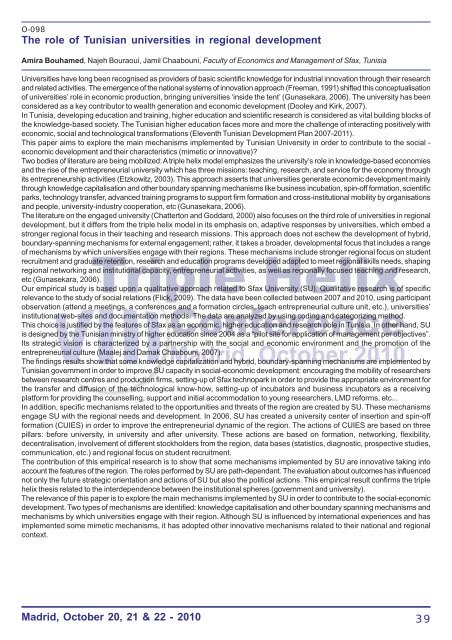TRIPLE HELIX noms.pmd
TRIPLE HELIX noms.pmd
TRIPLE HELIX noms.pmd
Create successful ePaper yourself
Turn your PDF publications into a flip-book with our unique Google optimized e-Paper software.
O-098The role of Tunisian universities in regional developmentAmira Bouhamed, Najeh Bouraoui, Jamil Chaabouni, Faculty of Economics and Management of Sfax, TunisiaUniversities have long been recognised as providers of basic scientific knowledge for industrial innovation through their researchand related activities. The emergence of the national systems of innovation approach (Freeman, 1991) shifted this conceptualisationof universities’ role in economic production, bringing universities ‘inside the tent’ (Gunasekara, 2006). The university has beenconsidered as a key contributor to wealth generation and economic development (Dooley and Kirk, 2007).In Tunisia, developing education and training, higher education and scientific research is considered as vital building blocks ofthe knowledge-based society. The Tunisian higher education faces more and more the challenge of interacting positively witheconomic, social and technological transformations (Eleventh Tunisian Development Plan 2007-2011).This paper aims to explore the main mechanisms implemented by Tunisian University in order to contribute to the social -economic development and their characteristics (mimetic or innovative)?Two bodies of literature are being mobilized: A triple helix model emphasizes the university’s role in knowledge-based economiesand the rise of the entrepreneurial university which has three missions: teaching, research, and service for the economy throughits entrepreneurship activities (Etzkowitz, 2003). This approach asserts that universities generate economic development mainlythrough knowledge capitalisation and other boundary spanning mechanisms like business incubation, spin-off formation, scientificparks, technology transfer, advanced training programs to support firm formation and cross-institutional mobility by organisationsand people, university-industry cooperation, etc (Gunasekara, 2006).The literature on the engaged university (Chatterton and Goddard, 2000) also focuses on the third role of universities in regionaldevelopment, but it differs from the triple helix model in its emphasis on, adaptive responses by universities, which embed astronger regional focus in their teaching and research missions. This approach does not eschew the development of hybrid,boundary-spanning mechanisms for external engagement; rather, it takes a broader, developmental focus that includes a rangeof mechanisms by which universities engage with their regions. These mechanisms include stronger regional focus on studentrecruitment and graduate retention, research and education programs developed adapted to meet regional skills needs, shapingregional networking and institutional capacity, entrepreneurial activities, as well as regionally focused teaching and research,etc (Gunasekara, 2006).Our empirical study is based upon a qualitative approach related to Sfax University (SU). Qualitative research is of specificrelevance to the study of social relations (Flick, 2009). The data have been collected between 2007 and 2010, using participantobservation (attend a meetings, a conferences and a formation circles, teach entrepreneurial culture unit, etc.), universities’institutional web-sites and documentation methods. The data are analyzed by using coding and categorizing method.This choice is justified by the features of Sfax as an economic, higher education and research pole in Tunisia. In other hand, SUis designed by the Tunisian ministry of higher education since 2004 as a “pilot site for application of management per objectives”.Its strategic vision is characterized by a partnership with the social and economic environment and the promotion of theentrepreneurial culture (Maalej and Damak Chaabouni, 2007).The findings results show that some knowledge capitalization and hybrid, boundary-spanning mechanisms are implemented byTunisian government in order to improve SU capacity in social-economic development: encouraging the mobility of researchersbetween research centres and production firms, setting-up of Sfax technopark in order to provide the appropriate environment forthe transfer and diffusion of the technological know-how, setting-up of incubators and business incubators as a receivingplatform for providing the counselling, support and initial accommodation to young researchers, LMD reforms, etc...In addition, specific mechanisms related to the opportunities and threats of the region are created by SU. These mechanismsengage SU with the regional needs and development. In 2006, SU has created a university center of insertion and spin-offformation (CUIES) in order to improve the entrepreneurial dynamic of the region. The actions of CUIES are based on threepillars: before university, in university and after university. These actions are based on formation, networking, flexibility,decentralisation, involvement of different stockholders from the region, data bases (statistics, diagnostic, prospective studies,communication, etc.) and regional focus on student recruitment.The contribution of this empirical research is to show that some mechanisms implemented by SU are innovative taking intoaccount the features of the region. The roles performed by SU are path-dependant. The evaluation about outcomes has influencednot only the future strategic orientation and actions of SU but also the political actions. This empirical result confirms the triplehelix thesis related to the interdependence between the institutional spheres (government and university).The relevance of this paper is to explore the main mechanisms implemented by SU in order to contribute to the social-economicdevelopment. Two types of mechanisms are identified: knowledge capitalisation and other boundary spanning mechanisms andmechanisms by which universities engage with their region. Although SU is influenced by international experiences and hasimplemented some mimetic mechanisms, it has adopted other innovative mechanisms related to their national and regionalcontext.Madrid, October 20, 21 & 22 - 201039










